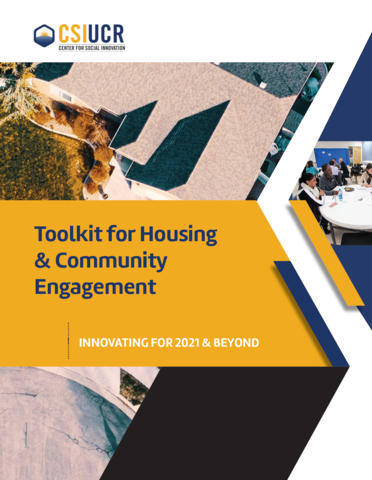Center for Social Innovation

Toolkit for Housing & Community Engagement: Innovating for 2021 & Beyond
Toolkit for Housing & Community Engagement: Innovating for 2021 & Beyond
In response to conversations around the most recent housing update, this toolkit is the result of discussions around community engagement, governmental policies, and how both can help address longstanding inequities. It builds on the existing expertise of planners, community advocates, and planning agencies, providing concrete examples of innovative methods that can deepen public engagement and tap into the planning profession’s desire for greater equity and sustainability.
At its core, community engagement is an integral part of the planning process, helping planners improve bi-directional communication, increase satisfaction, and strengthen public trust in government agencies. It also plays a key role in uplifting the voices of community members, helping to provide an opportunity for even the most marginalized to provide their input and lived expertise. This is particularly important as community members are the most directly impacted by the choices made, but may not have traditional subject-specific technical expertise nor feel that they have enough power to play a significant role in the process. Within this context, this toolkit aims to support several goals of community engagement, namely (1) increasing awareness/transparency, trust, and satisfaction, (2) eliminating inequities (including structural), and (3) meeting requirements & finding solutions.
Many agencies are well-versed in holding and running community forums and meetings, widening the reach of public information and expanding the ability of communities to give input regarding new developments and modifications to existing policies. And while there are many instances of planning departments moving beyond standard meetings, resources such as online tools can further the reach of critical information and provide greater flexibility for engagement. This toolkit aims to provide resources and ideas for municipalities, but also to provide community-based organizations with background information so they can better integrate their advocacy work.
The recommendations come from a community-asset-based lens, recognize the resource constraints that many agencies face (such as in personnel, technology, finances, and time), and suggest ways to utilize resources most effectively and efficiently. In addition, these can be used to jumpstart brainstorming for the type of specific innovation needed for each individual place and circumstance. Some key recommendations include:
- Be aware of the assets a community already has and can bring to any planning process. Lived experiences are important, and counts as expertise.
- Trusted messengers are one way to start making inroads with hard-to-engage populations. They can take many forms (e.g., community organizations, nonprofits, community health workers/promotoras), and can also serve as a liaison to help build capacity within communities.
- Not all innovation needs to be splashy. In many instances, small tweaks such as increasing the amount of time allowed to provide public comment/input serve as comparatively low-resource-intensive modifications that can lead to increased participation.
- Be creative and open to different ways standard outreach can be run. Exercises such as role-playing can provide an opportunity for people to think differently about issues as well as open up the floor for formal and informal conversations.
- Providing options to build up infrastructure with communities (e.g., equipping communities with data and other related tools, providing leadership training and mentoring) can help create a solid foundation for long-term engagement.
- Remember to say thank you! Showing gratitude is important, and can help create a positive experience, particularly for those who are new to the process.
Also included is a framework to evaluate engagement processes as well as outcomes, helping communities and agencies establish lines of communication in order to move closer in their mutual quest to advance equity, sustainability, shared prosperity, and high quality of life.
Notably, this toolkit also directly acknowledges that it is the product of one moment in the ongoing evolution of what community engagement is and can aspire to be. With this in mind, this is meant to be a living document, and as such will need to be revisited as resources and context change, and approaches are further refined.
